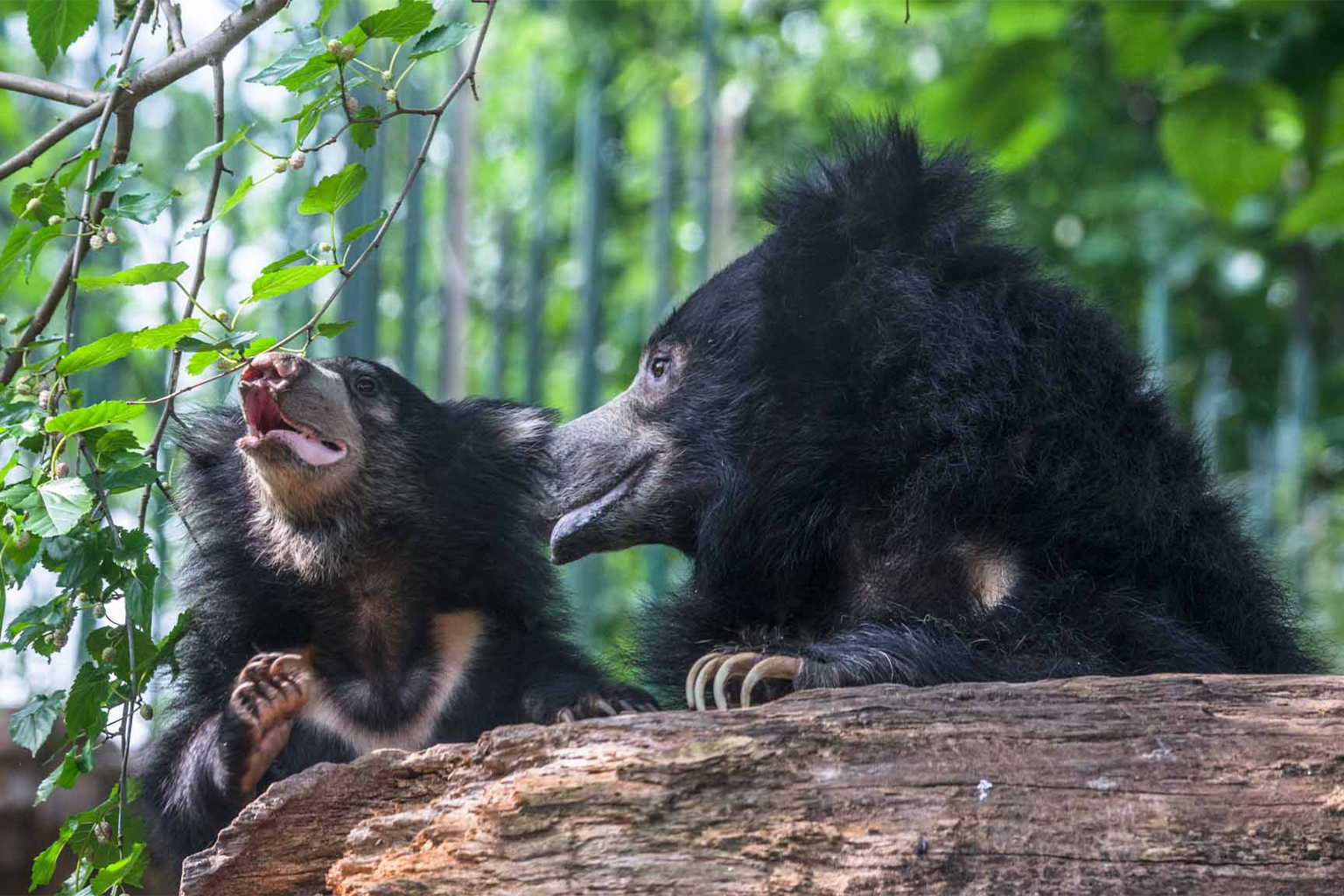- Nepal and India have made huge strides in boosting their tiger populations over the past decade, but these conservation actions may have come at the expense of other predators, research shows.
- In Nepal, species such as leopards and sloth bears have been pushed to the fringes of conservation areas that have been optimized for tigers, leading to increased human-wildlife conflict.
- The current approach of burning tall grasses and rooting out tree shoots to give deer and antelope fresh grass, and tigers fresh prey, isn’t even working in the tigers’ favor, one study shows.
- Conservationists say there needs to be a habitat management approach that accommodates a wider range of both prey and predator species.
KATHMANDU — The monsoon season in Nepal is expected to begin in the second week of June, which means officials in the country’s prime habitats for Bengal tigers (Panthera tigris tigris) are busy with their seasonal work. They’re setting fire to the tall grasses that grew throughout the year, and uprooting trees that may have sprouted in the grasslands, all to ensure that the endangered species has a suitable habitat for the rest of the year.
These actions, authorities say, will help get rid of dried grass and regrow nutritious sprouts for herbivores such as deer and antelopes, the tigers’ prey of choice in the wild, and thus help in the conservation of the iconic species.
“Tigers are umbrella species. This means that if we manage the habitats for tigers, it will automatically benefit other animals and plants in the wild,” says Ramesh Kumar Thapa, former warden of Bardiya National Park in western Nepal. “We have been following this principle for a long time and it seems to be working.”
Conservationists who agree with Thapa credit this habitat management approach with Nepal’s success as one of the few countries in the world where tiger numbers have nearly doubled in the past decade. They also make the case that the approach mimics the traditional practices of Indigenous people — evicted from their homeland when the park was established — to slash and burn tall grass to help check the growth of trees and allow fresh grass to grow.
But some conservationists, as well as a growing body of research in the tiger strongholds of Nepal and India, say that what’s good for tigers isn’t always good for all animals — especially other predators that share the tigers’ habitat.

The approach is reminiscent of efforts in China aimed at conserving that country’s flagship and umbrella species, the giant panda. A 2020 study found that other species, such as leopards (Panthera pardus), snow leopards (Panthera uncia), wolves (Canis lupus) and dholes (Cuon alpinus), saw their habitat in protected areas in the giant panda’s range shrink drastically since the 1960s.
When it comes to tiger conservation, it’s the same species — leopards, wolves, dholes — as well as sloth bears (Melursus ursinus), fishing cats (Prionailurus viverrinus), hyenas (Hyaena hyaena) and jackals (Canis aureus) that get the short end.
“As we focus on tigers, other species are not getting the required attention,” says Maheshwor Dhakal, former warden of Chitwan National Park who is now member-secretary of the President Chure-Terai Madesh Conservation Development Board. “There is growing evidence that tiger-focused grassland management may not be good for all animals in the ecosystem, especially ones that have the same prey base as the tigers,” he says. “Take, for example, the common leopard, which has a similar prey base as that of the tigers. They are also facing habitat losses and other anthropogenic pressures, but the traditional method of grassland management doesn’t address their needs.”
The expansion of tiger habitat pushes leopards to the margins of protected areas, where they become more likely to get into conflicts with local people, Dhakal says.
It’s a similar story with sloth bears, which live in the floodplains of the Terai Arc Landscape that spans Nepal and India. A recent study on the elusive species suggests that tiger-focused habitat management in protected areas could add challenges to the conservation of the vulnerable sloth bears.
“Sloth bears have specific feeding and habitat requirements. They feed mainly on termites found in fruit trees,” says Babu Ram Lamichhane, one of the co-authors of the paper. The paper notes that, due to this reason, it’s difficult for sloth bears to adapt to changes in their habitat. “Focus on grasslands and tiger habitats could mean that they get less termites to eat,” Lamichhane tells Mongabay.
When limited resources are focused toward management of habitats for tigers, small cats such as fishing cats suffer, says Rama Mishra, a Ph.D. candidate at the University of Antwerp and co-founder of the Wildlife Conservation Association Nepal. Fishing cats are also endangered and need a habitat different from that of tigers, she says
A 2018 report by India’s National Tiger Conservation Authority and the Wildlife Institute of India also indicates that habitats of species such as sloth bears, hyenas, dholes, wolves and jackals may be shrinking, and that tiger-centric policies may not save them.
Lamichhane says he believes that certain species such as the binturong, also known as the bearcat (Arctictis binturong), and other elusive animals that are yet to be recorded may be present in protected areas of the Terai Arc landscape, and that an approach focused on tigers may not be suitable for them.

Current practices not optimal even for tigers
As governments and NGOs focus on tigers and management of their habitat, current practices may not even be optimally beneficial for the big cats, new research suggests.
“We found that a blanket approach of setting fire to grasslands to manage habitats for tigers may not be desirable,” says lead author Shyam Kumar Thapa, from Nepal’s National Trust for Nature Conservation.
Thapa and his colleagues, who observed controlled fires in Bardiya National Park, found that different species of deer and other herbivores used grasslands at different times after it was set on fire. Some deer used it immediately, while others waited for weeks before grazing there.
“Large-scale single event fires, thus, may not fulfil nutritional requirements of all species in the deer assemblage in these subtropical monsoon grasslands,” the study says. “This is likely because the nutritional requirements of herbivores differ due to differences in body size and physiological needs — maintenance, reproduction, and lactation.”
Thapa says the study shows the importance of having a mosaic of habitats to make the most of the grazing habits of the various herbivore species to provide them with adequate nutrition. The mosaic would incorporate grasslands at different stages of development, areas with trees and water, and other habitats for specialist animals. This would directly benefit the tigers by giving them a wider availability of prey. “Such a mosaic habitat would be suitable for other species as well,” Thapa says.
For Dhakal, an alternative to the tiger-centric approach involves data-driven decision-making on the management of habitats in protected areas.
“We need data on the nutritional requirements of each species and how these requirements can be fulfilled by other species,” he says. “When we have such data, we can plan our approach accordingly.”
Banner image: A Bengal tiger in Nepal’s Chitwan National Park. Image by AceVisionNepal77 via Wikimedia Commons (CC BY-SA 4.0).
Citations:
Jhala, Y. V., Qureshi, Q., & Nayak, A. K. (2019). Status of tigers, copredators and prey in India 2018. Retrieved from Indian Ministry of Environment, Forest and Climate Change website: https://moef.gov.in/wp-content/uploads/2020/07/Tiger-Status-Report-2018_For-Web_compressed_compressed.pdf
Li, S., McShea, W. J., Wang, D., Gu, X., Zhang, X., Zhang, L., & Shen, X. (2020). Retreat of large carnivores across the giant panda distribution range. Nature Ecology & Evolution, 4(10), 1327-1331. doi:10.1038/s41559-020-1260-0
Paudel, R. P., Kadariya, R., Lamichhane, B. R., Subedi, N., Sashika, M., Shimozuru, M., & Tsubota, T. (2022). Habitat occupancy of sloth bear Melursus ursinus in Chitwan National Park, Nepal. Ecology and Evolution, 12(3). doi:10.1002/ece3.8699
Thapa, S. K., Jong, J. F., Hof, A. R., Subedi, N., Joshi, L. R., & Prins, H. H. (2022). Fire and forage quality: Postfire regrowth quality and pyric herbivory in subtropical grasslands of Nepal. Ecology and Evolution, 12(4). doi:10.1002/ece3.8794
Feedback: Use this form to send a message to the author of this post. If you want to post a public comment, you can do that at the bottom of the page.
